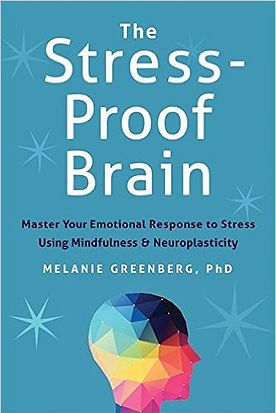I’m delighted to host this guest post by one of my favorite authors, psychologist Dr. Melanie Greenberg, in honor of the release of her excellent new book The Stress-Proof Brain. In her post, she explains how our brains produce and control stress and shares three proven techniques that help you master your brain’s response to stress.

Leadership can be stressful! In today’s changing, unpredictable, and fast-moving world, the ability to manage stress can be one of the greatest challenges a leader faces. We all know of leaders whose inability to manage stress hurt their organizations and their careers. Unmanaged stress can drive leaders to yell at employees and treat them disrespectfully, to set goals that are not well thought out, to not show up when most needed, or to wear themselves out so much it hinders their performance.
On the flip side, properly managed stress can act as a motivating force that helps you power through difficulties and get up again when you fall down. Part of the stress response includes adrenaline, which is an energizing, activating chemical. If you learn to see your stress as a difficult, but manageable challenge in service of goals you are passionate about, you can experience the adrenaline rush as excitement and harness its energy to help you be stronger, work smarter and accomplish more.
The stress response begins when your amygdala – an almond shaped structure in the center of your brain – senses a threat. It reacts by initiating a cascade of neurotransmitters and hormones – like adrenaline, norepinephrine, and cortisol, that rapidly prepare your body for “fight or flight.”
The “fight, flight” response is adaptive to help you survive an immediate danger, but becomes problematic when you’re dealing with more chronic stressors. Your amygdala can “hijack” your brain and cause you to say things you later regret or behave in impulsive, destructive ways. To succeed as a leader, you need to know how to get back on track when your amygdala sways you off balance. Luckily, there is a part of your brain that can help you do this.
Your prefrontal cortex, located just behind your forehead is your brain’s executive center. It receives information from your amygdala, and integrates it with information from other areas about your purpose and goals, ability to cope, what actions need to be taken, and how well these worked out in the past. It feeds this information back to your amygdala to help calm it down when you believe the danger is over. It also initiates action plans in other parts of your brain.
Three Skills that Help You Master Your Brain’s Response to Stress
Resilient brain skills can help you calm down your amygdala and recruit your prefrontal cortex to help you move forward in a strategic and helpful way. By learning and practicing these skills over months or years, you can actually grow new brain neurons and pathways.
1. Mindfulness
Mindfulness, an ancient Buddhist practice, is now used by leaders in companies like Google, General Mills and Aetna. Research studies support its benefits in managing stress, reducing depression and anxiety, improving physical health, and relationships. Brain imaging studies show that an 8-week mindfulness training can actually help shrink the amygdala and strengthen the prefrontal cortex, as well as the connections between them.
To be mindful under stress, you have to practice being mindful on a regular basis when you are not stressed. Mindfulness involves taking a compassionate, curious, accepting stance towards your experience in the moment, whatever that may be. It means taking a step back and slowing things down so you can notice what you are thinking, feeling, and sensing. It is the “precious pause” between stimulus and response. By noticing signs of stress like quickened breathing, you have more choice what to do with those feelings like breathing and slowing down or reminding yourself of what’s most important.
2. Cognitive Flexibility
Cognitive flexibility comes from your prefrontal cortex. It involves finding a way to view the stressful situation from a different perspective so as to generate different feelings. Stress and anxiety tend to make us defensive and self-protective. Being cognitively flexible involves deliberately broadening your view to see the larger purpose or common interests. Perhaps you both want to do what is best for customers, but have different opinions about what that is. Or it may mean reframing the stressor as a manageable challenge that you have the skills to deal with, rather than an overwhelming threat. This allows you to feel more confident and calms down your amygdala’s perceptions of danger.
3. Bringing in the Positive
Bringing in the positive involves finding a way to generate positive emotions and states. Research shows that positive states of mind like joy, interest, or humor can help calm us down physiologically from negative emotions. One positive state that can be useful to leaders is called “flow” or “getting into the zone.” Flow comes from a pleasant immersion in whatever task you are doing at the moment, knowing that the demands of the task are a good match to your skills. Another effect of positive states of mind is that they broaden your thinking, so you’re more likely to come up with creative solutions. So when you face stress as a leader, think about your passion for your goals, the people you love, or the things in life that you are grateful for.
Note from Jesse: Stress is a fact of life in today’s world, but it doesn’t need to run your life. Learn how to make stress work for you in The Stress-Proof Brain. Dr. Melanie Greenberg’s wonderful new book is filled with practical, easy-to-understand tips to master your brain’s response to stress, become more resilient and experience more positivity in your life.
 Melanie Greenberg, Ph.D., is a practicing psychologist and executive coach in Mill Valley, California, and former professor and researcher. An expert on stress, relationships, the brain, and mindfulness, she provides workshops, speaking engagements, coaching, and psychotherapy. She regularly appears as an expert in national media and writes the Mindful Self-Express blog for Psychology Today, Visit her website, like her page on Facebook, and follow her on Twitter.
Melanie Greenberg, Ph.D., is a practicing psychologist and executive coach in Mill Valley, California, and former professor and researcher. An expert on stress, relationships, the brain, and mindfulness, she provides workshops, speaking engagements, coaching, and psychotherapy. She regularly appears as an expert in national media and writes the Mindful Self-Express blog for Psychology Today, Visit her website, like her page on Facebook, and follow her on Twitter.
Learn more about her newest book: The Stress-Proof Brain: Master Your Emotional Response to Stress Using Mindfulness and Neuroplasticity












